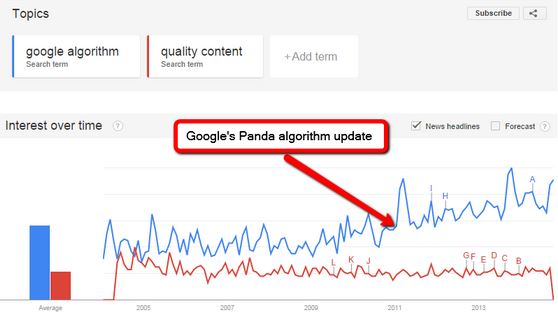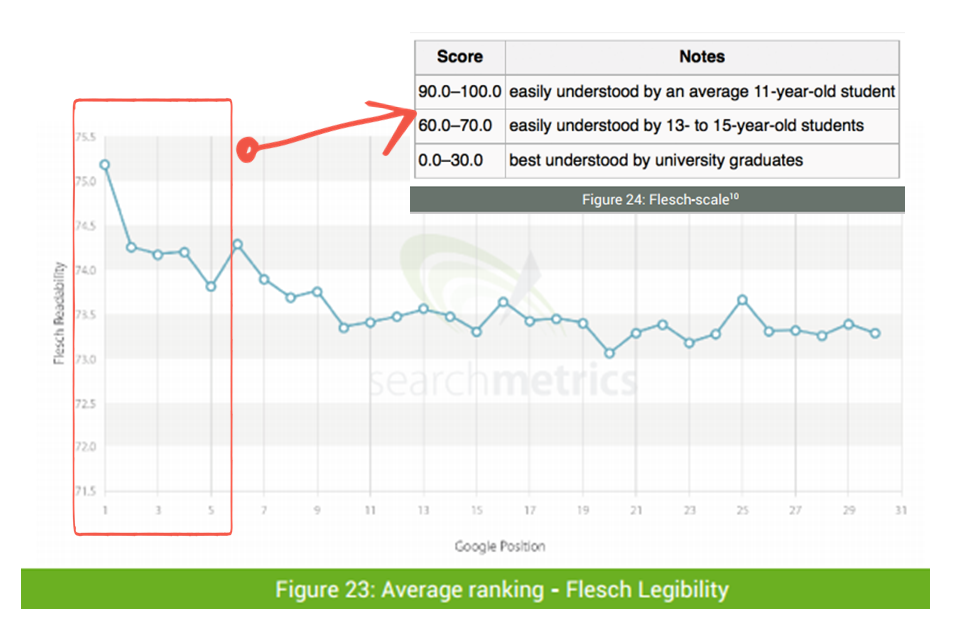Since Google first announced the Panda algorithm in February 2011, marketers, SEOs and webmasters have scrambled to make sure their web properties have “high-quality content”. After all, Google’s blog post about the update was titled, “Finding more high-quality sites in search,” and the post itself made several vague references to mysterious “high-quality” and “low-quality” sites.
When we all started chasing the wrong answers
The algorithm update affected nearly 12 percent of queries, so naturally, it got a reaction from marketers and webmasters … just not the reaction you might expect. Instead of quickly trying to figure out just what Google meant by “high-quality sites,” we (yes, I take some of the blame) started focusing even more on the algorithms behind Google’s search engine. Check out this graph that compares overall interest in “Google algorithm” and “quality content:”
Seriously? Google announces an algorithm update that drastically changes the way it serves up results based on quality and usefulness, and all we do is look out for more algorithm updates? Google just told us what we need to do to help our rankings! Shouldn’t everybody have gone crazy figuring out just what Google means by “quality content? Why wasn’t that the focus?
Deep breath, Colin. It’s over now.
The problem that graph above illustrates is a fundamental disconnect between the way people think of marketing online and just plain old marketing. Not only is our fixation on algorithms off-base, the title of this article hints that asking “what is high-quality content?” is the wrong question, too. Here’s why:
As creative, yet analytical, left-and-right-brained, intuitive and deductive marketers, we have done the proper audience research and know the benefits we offer. Thus, we should know what our prospects need to hear in order to feel ready to buy from us. You do not need a Google algorithm to tell you how to answer questions your prospects are asking in search. That’s silly. Google doesn’t know your prospects. You do.
But in case you did need Google to tell you that, site the search engine’s quality guidelines were leaked last summer. You can read all 160 pages, if it pleases you. If it doesn’t, look no further than this next sentence:
Google wants each page on your site to fulfill its purpose within the context of the overall purpose of your site as efficiently as possible. 
In other words:
- If moving an ad would make the page easier to read, do it.
- If adding a calculator to your page about mortgage rate calculations would make your page more informative or useful, do it.
- If re-titling the page so it’s more specific to its actual purpose, but still related to your overall site’s purpose, do it. If a page serves no real purpose, take it down.
That’s pretty simple, but it doesn’t even need to be that complicated.
Useful content is quality content
As I was slogging through the guidelines, it struck me: They were very easy to understand, and very effectively fulfilled their purpose. (They were written to direct the grading efforts of real human site quality graders.) In fact, I didn’t feel like I was ‘slogging’ at all! It was good content. It brought to mind a report from Searchmetrics that essentially said that content online should be written so an 11 year old could understand it without difficulty.
Good content is simple. It’s readable and useful and persuasive. But there are also some realistic challenges you can’t ignore. How do you know your idea of quality content matches your readers’ expectations?
A lot of my clients spend so much time on their site, reading and re-reading their landing pages, and tweaking landing pages that they lose their perspective. And that’s okay, but there are other ways to get an objective review:
- A good way to get feedback on the effectiveness of your site is to use a tool called the 5-Second Test. We use it all the time to help get feedback on new pages on our clients’ sites. (Check out this blog post for an up-close look at how the 5-Second Test works in action.)
- Or, more simply, ask colleagues, family members, friends not in your industry to visit your site. Watch over their shoulders to see where they stumble. Those are the pages that need work.
I liken Google’s quest for quality content to movies. You don’t need to study cinematography to know that Matrix Revolutions was not as good as the original. It’s the same with web copy. It’s a quality page if it does its job. Step back, take a look at your site, then dive back in!




